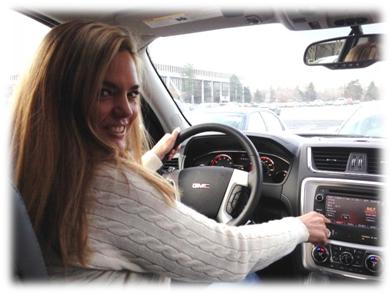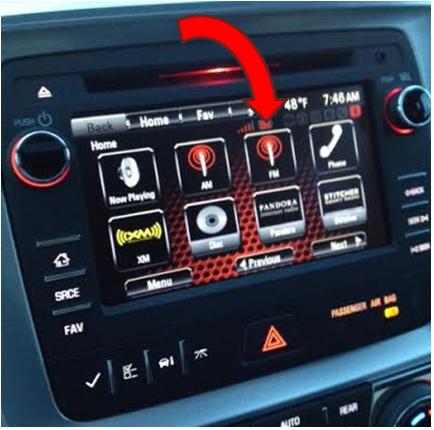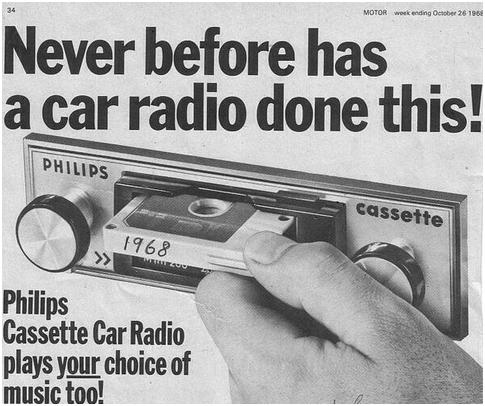The DASH conference back in October was an eye-opening experience for many broadcasters, including Lori Lewis. As it turned out, she was in the market for a new vehicle, so the timing was perfect. As Lori will tell you, she’s not a telematics expert, but her introduction to a digital dashboard echoes what many radio listeners will be experiencing as they trade in an old car and move up to a 2014 model. – FJ
Ever since the DASH conference last month (and after racking up 150,000 miles on my 2007 Yukon), I realized it was time to move on and fully experience a “connected car.”
Would it really alter my car radio experience?
 After deciding on the 2014 GMC Acadia, the first thing I noticed when I sat down was that the car radio had been replaced by this all-consuming (slightly intimidating) entertainment system.
After deciding on the 2014 GMC Acadia, the first thing I noticed when I sat down was that the car radio had been replaced by this all-consuming (slightly intimidating) entertainment system.
The satellite radio app was at the top of the “dashboard stack.” I didn’t want that. So I hit the “next” button to find what I was looking for – FM radio. But the options that showed up were apps like Pandora, Stitcher, Bluetooth, CDs, etc. No FM radio.
I finally asked my salesman, “Where’s the radio?”
He proceeded to show me how to get to the “FM” icon (buried on the bottom of the digital dash stack) and how you can actually reposition the “FM” app to occupy the top of the stack – the front page. But it wasn’t simple and I had to ask.
And so my digital dash looked like this on day one:
What was alarming about having to “work” for FM radio is the fact that every day, a segment of radio’s audience is going through this same experience: learning the digital dash and (hopefully) trying to find your station through the clutter.
It can be distracting and cumbersome.
But when we look back, radio has faced its share of consumer distractions over the years, like this gem from 1968 when Phillips introduced the “Cassette Car Radio.”
So this post isn’t about technology threatening our storied industry.
It’s about understanding the new realities of the “connected car,” and what you’re up against in the new car market. The elements of these digital dashboards have enhanced the in-car audio experience in some areas but it has also reshaped radio’s in-car reality.
Below are five early observations I’ve reached from a consumer’s point of view:
1. HD-2 Channels Are Under Estimated
For the first time since 2006, (when I was tasked to create an HD-2 station in Baltimore and loathed it mostly because I didn’t understand its worth), I am now a fan of HD-2 stations.
Don’t dismiss them. The music is fun – sometimes weird fun – but what’s really nice is having FM radio channels to flip to during those bow-tie stop sets every station in the market seems to go into simultaneously. HD-2 channels are a reason to not use the pure plays.
2. HD-2 Stations Should Be The New Overnights
But with that said, the novelty of unique programming will never trump the missing human element. HD-2 stations should be ripe with interns and fledgling DJs, honing their craft (and keeping listeners company).
3. You Don’t Have A Lot Of Time
Knowing the digital dash offers this massive volume of entertainment choices at our fingertips (literally – on the steering wheel), there’s a lower tolerance for substandard content and self-indulgent breaks. Remember we live in a “selfie” world right now. It’s all about how it connects to “me.”
4. 13 Year-Olds Still Like Radio
The kids are listening. I watch them. However, as it was pointed out in an earlier blog – technology has shifted what was the era of entitlement to a new era of “earn.”
You have to earn their attention. These kids don’t wait around. If you interrupt their experience, they love pairing their iPhones to the dash via Bluetooth and playing their iTunes library. Again, self-involved breaks are especially erosive. Tell them something they don’t already know.
And BTW, my daughter and her friends plug their phones into the car not because they don’t like radio – it’s just really cool to have their playlists and libraries come through the speakers of the vehicle.
Imagine when you were a kid having all of your 45s or cassettes plugged into the family car on those long car rides.
It’s just cool. Radio has to work harder to match that cool.
5. The Phone Removes You
When we use our phones in these “connected cars,” the calls take over the sound system and everything else (including the radio) is muted. This feature isn’t anything really new (or anything we have control over) but it’s a good reminder to keep working on content and a reputation that’s so good, they’ll maybe skip an incoming call – when possible – or hold off using the phone because they don’t want to miss a minute with you.
I’m sure other observations will surface from this new digital dash – it’s wonderful for the consumer but somewhat uneasy technology for radio to confront.
And while the big auto executives made it clear at DASH that there are no plans in the foreseeable future to remove broadcast radio from the automobile, we should look at this as an opportunity to work smarter and be better so we earn first place in the “dashboard stack.”
One of the “takeaways” from Fred and Roger Lanctot’s presentation at the “Radio Show” will be reiterated at the Nielsen Client Conference this week: there’s a strong need for a consortium of radio executives to tackle the challenges and opportunities presented by the “connected car.” It was also something that Peter Smyth floated at DASH.
My personal experience with a “connected car” suggests that radio ought to be doing this sooner rather than later.






takeaway is the perfect word for the connected car and radios role. What takeaway will a listener have with your station? Tell me something new, funny, or relatable to MY WORLD. Great column. (told you – Lori smart. I listen.)
It’s a new reality but one I see radio flourishing in. And thank you, Jim. Your support has always been appreciated. Great job over at WCSX!
I retired from radio twenty years ago, but have never lost my love of the medium. I’m listening to a local talk station now. My home and car radios get a workout on AM and FM every day.
But I also enjoy satellite radio in my car, and on my digital devices. One of my former colleagues, Jim Sykes, is on SiriusXM’s Elvis Station. The original MTV veejays can be heard on satellite. I can finally hear the legendary Cousin Brucie. And satellite radio keeps me in touch with what’s happening nationally through news and talk channels that aren’t available locally. Not everyone lives in a city with 50-plus AM and FM signals, so I believe satellite radio has its place alongside AM and FM; it isn’t a replacement, but merely a supplement … until I want information about the local weather, traffic, news or sports, or just want to hear music that’s tailored to local tastes.
Thanks, Walter. But it’s up to local radio to prove its value in an increasingly competitive environment. Thanks for the perspective and for taking the time.
To coin a word: Earntitlement!
Secondly, any radio person who buys a new car should figure out the problems keeping FM/AM prominent on the digital dash in their new model and create a how-to video and upload it to YouTube. Link it to your station website for listener benefit and share it with the rest of us.
Better yet – make this a sales opportunity: Send the sales team with an air talent to the various dealerships in your market and create these short tutorial videos right there in the showroom as part of a schedule with the dealership. Package these videos together on your site as part of a comprehensive set of instructions for people to easily access your brand.
Even Mo’ Better: Perhaps this is an industry-wide campaign best executed by the NAB in partnership with the automakers utilizing radio’s highest wattage personalities and the best possible production values.
Jay, thanks for the great comments. As we have preached for a few years now, radio is behind the curve of the “connected car” space. Our Arbitron presentation with Roger Lanctot at the Radio Show was the appetizer; our DASH conference here in Detroit was the 5-course meal. We’re back with dessert at the Nielsen Client Conference lunch tomorrow in Baltimore. It’s time the radio industry wakes up to this challenge – and the opportunities it presents.
Thanks for your passion and for contributing to the conversation.
Content will always solve all of our problems. 🙂
I will tell you one thing I discovered about the connected car. On a recent trip in a rental car, I realized that they are a real road hazard. Using the touch screen was really stressful while driving. You have got to take your eyes off of the road to try to find what you want. It sounds strange, but I think that connected cars of the future would benefit from more “analog styled” controls (knobs, switches and buttons) that don’t require your eyeballs. Operating a traditional radio is tactile so it can be done without even thinking. That said, there are lots of choices to be found if you can take your eyes off of the road long enough to search for them.
I hear you, Stephen. One feature I appreciate in the GMC Acadia I’m driving is that all of the buttons are also on my steering wheel. So once I memorize (by feel) which buttons do what – it’s easier to keep the eyes on the road.
Lori — I totally agree with points 1 & 2 about the importance of HD2. I’d recommend using it for young DJs…and exploring new music (particularly local bands). Young DJs should be going out to clubs and finding the best local talent…interviewing them on air…playing their music and making HD2 what “FM Radio” was in the 1970s. That keeps you “live, local and young”.
Those are great points, James. Thank you!
Interesting and thought provoking post Fred, as always.
When I came back from DASH, the first thing I did was call my best car client and ask them to come out in early January..and walk every announcer and promotions/digital person in my building through a brand new digital dash. They need to SIT in the car, just like the Detroit radio guys and not only understand it…but feel what it’s like for a consumer to experience that and the true choices they have on a daily basis.
It’s just a first step..but a really good one, IMO. You only know what you know. 🙂
Dave, it thrills me to no end to see a smart broadcaster do something strategic because of DASH. Thanks for the story and for adding to the conversation.
ACCK….didn’t mean to leave you out Lori…it was your post! 🙂
It’s all good, DP. We are a family here. And thank you for taking the time to attend DASH and let us know what you’re up to since! Great moves!
Does anyone really believe a “consortium of radio executives” would be able to produce anything that isn’t entirely self-centered?
They seem to view the connected car (and the internet, for that matter) as a threat.
That makes them think more about themselves than the users experience.
While Pandora, Slacker, Spotify, iTunes Radio etc… are collecting reams of data on users patterns, preferences/ roadblocks and iterating improvements with each dot release – the Radio execs that might make up such a consortium have pulled back on research, marketing, talent development and turned many stations into not much more than a computer generated playlist feeding audio to a FM Transmitter.
They have also generally shown to be at least 5 years behind most tech standards (just look at radio websites – it’s a way-back machine)
The only true exception I’m aware of is iHeartRadio.
All I can imagine such a consortium producing is a commitment to lobby to make sure AM/FM/HD Radio has prime “end cap” space in all connected displays. “First Page or Bust!”
Or some ridiculous dollar amount of inventory dedicated to “educating the consumer” about the power of AM/FM/HD Radio over all the other “choices”
Fred, you know all these guys – please tell me I’m missing something. Please? 🙂
I have thought long and hard about the value of a consortium – what would it accomplish, who would do the heavy lifting, and would it amount to anything. And then I thought about what happens if radio does nothing? So I lean toward the first option in the hope that an educated broadcaster and the power of multiple companies could make a difference. Your cynicism is understandable and similar initiatives in the past have not been wildly successful. But given that the car is #1 for listening and for revenue, I have to believe that smart people will make the connection. I also think it’s interesting that individual broadcasters can be difference-makers, too. And maybe there’s something to be said for that. Read Dave Paulus’ comments for this post, an interesting story to be sure. Thanks, Jeff.
It’s just silly FAD! LOL!
Does this ‘radio’ offer HD on AM or HD2 on FM?